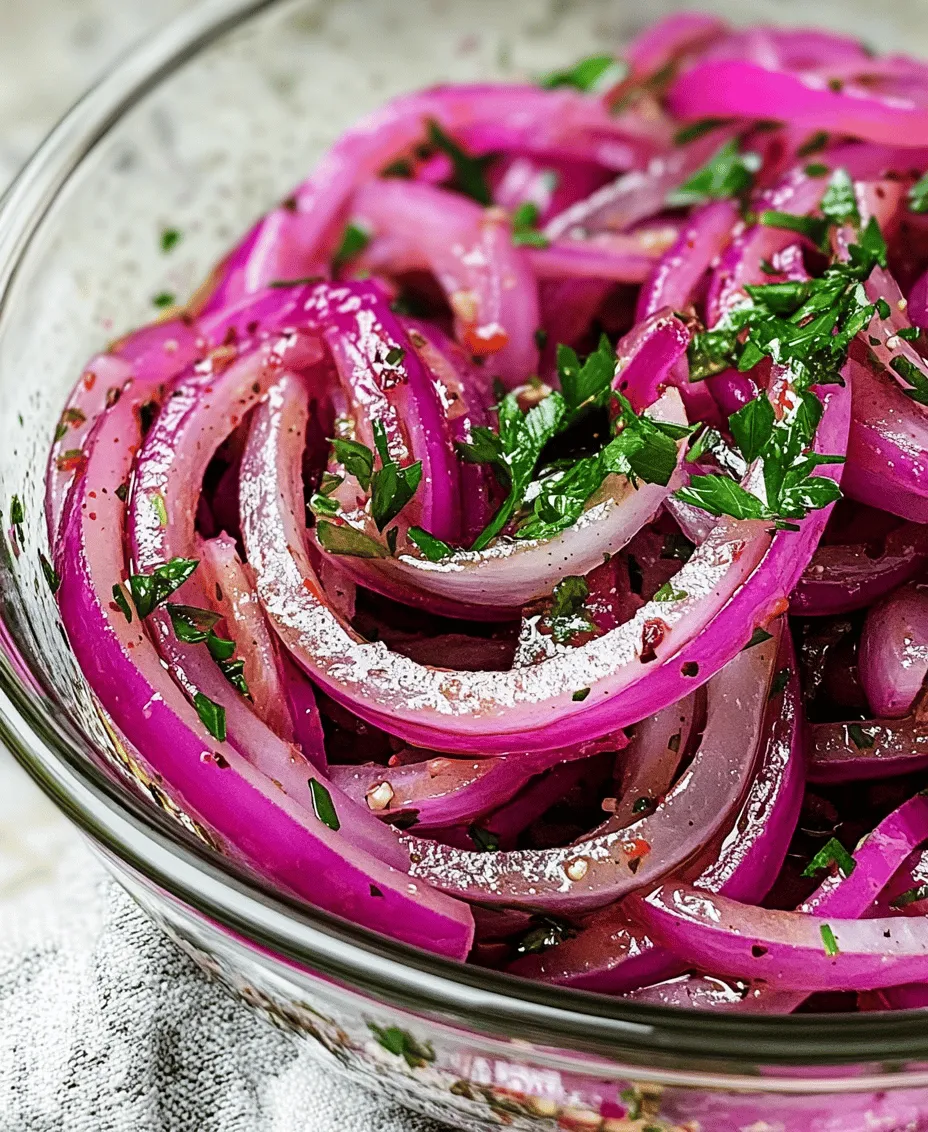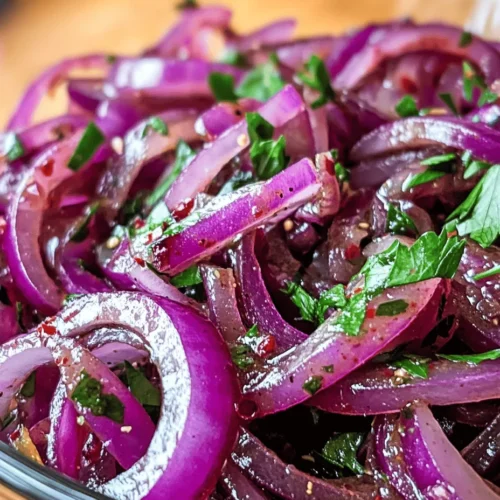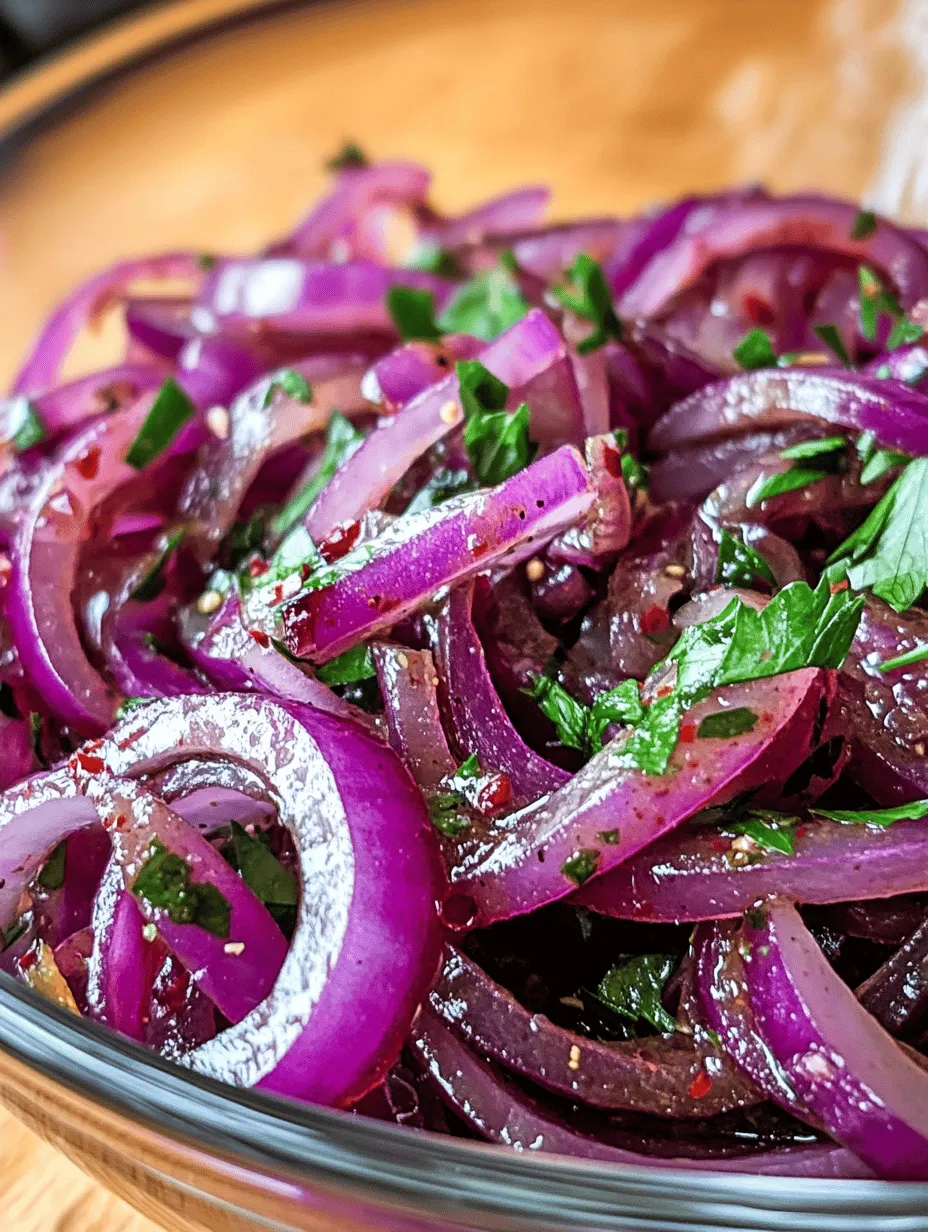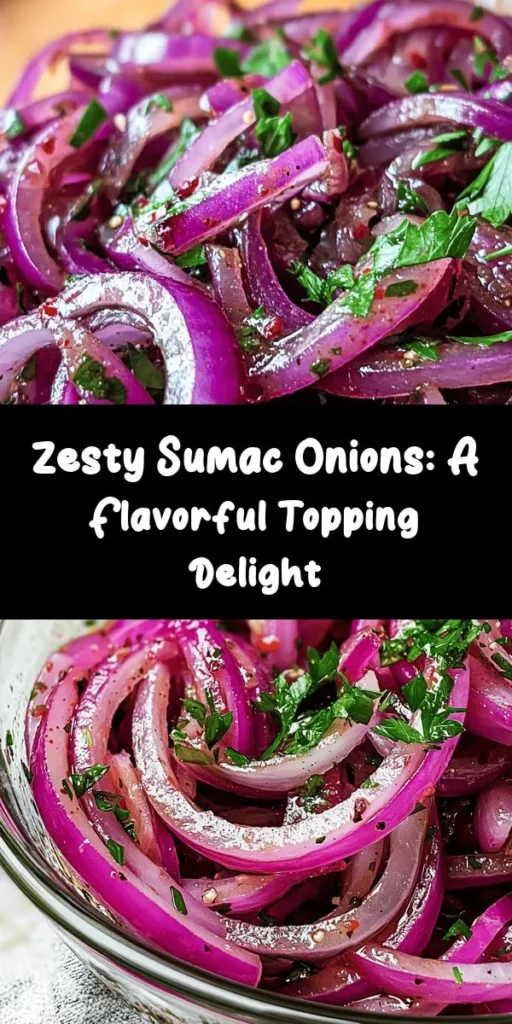Introduction
If you’re looking to elevate your culinary creations, zesty sumac onions are a fantastic way to add a burst of flavor to your dishes. Originating from the Middle East, sumac has become increasingly popular in kitchens around the globe due to its tangy, lemony flavor that can brighten up any meal. When paired with the vibrant sweetness of red onions, this recipe transforms a simple ingredient into a tantalizing condiment that enhances the taste of salads, grilled meats, wraps, and more.
The unique flavors of sumac onions make them incredibly versatile, fitting seamlessly into various cuisines—from Mediterranean to Indian. Their delightful tartness can cut through the richness of fatty dishes, adding a refreshing contrast that keeps your palate engaged. Whether you’re hosting a dinner party or simply looking to spice up a weeknight meal, zesty sumac onions are sure to impress.
Understanding Sumac: The Star Ingredient
To truly appreciate zesty sumac onions, it’s essential to understand the key ingredient: sumac spice. Sumac is derived from the berries of the sumac plant, which are dried and ground into a fine powder. With its deep red hue, sumac not only adds a pop of color to your dishes but also introduces a unique flavor profile characterized by its tartness. The aroma of sumac is earthy and slightly fruity, making it a delightful addition to many dishes.
Culinary uses of sumac are vast and varied. In Middle Eastern cuisine, it is often sprinkled over kebabs, salads, and rice dishes, where it complements and enhances the existing flavors. Additionally, it can be used as a souring agent in place of lemon or vinegar, creating a complex layer of taste in everything from dips to marinades. In Turkish cuisine, sumac is commonly added to spice blends like za’atar, which can be used for seasoning bread or meats.
From a nutritional standpoint, sumac is rich in antioxidants and has been known to provide several health benefits. It is thought to have anti-inflammatory properties, can aid in digestion, and may even help regulate blood sugar levels. Incorporating sumac into your diet not only adds flavor but can also contribute to your overall well-being.
The Beauty of Red Onions
Red onions are the perfect companion for sumac, bringing their own distinct flavor and color to the table. Known for their mildly sweet taste and vibrant hue, red onions are a staple in many cuisines around the world. Their unique flavor profile makes them ideal for raw applications, such as salads and salsas, as well as cooked dishes where their sweetness can be enhanced through caramelization.
In addition to their culinary appeal, red onions are packed with nutrients. They are an excellent source of vitamins C and B6, manganese, and dietary fiber. The antioxidants found in red onions, particularly quercetin, are known for their potential health benefits, including anti-inflammatory effects and support for heart health. Furthermore, red onions have been linked to boosting the immune system and promoting healthy digestion.
When selecting red onions at the market, look for bulbs that are firm to the touch, with dry, papery skin and no soft spots or blemishes. A good red onion should have a vibrant color, indicating freshness and quality. Store them in a cool, dark place to prolong their shelf life, and avoid keeping them in the refrigerator, which can cause them to become soft and lose their flavor.
Ingredients Breakdown
Creating zesty sumac onions requires just a few simple ingredients, but the quality of these ingredients can significantly impact the final result. Here’s a detailed breakdown of what you’ll need:
Essential Ingredients:
– Red Onions: The star of the dish, red onions provide sweetness and color. You’ll need about two medium-sized red onions for this recipe.
– Sumac Spice: The key flavoring agent, sumac will lend its characteristic tanginess to the onions.
– Olive Oil: A good quality extra virgin olive oil will enhance the overall flavor and provide richness.
– Salt: A pinch of salt helps to release the moisture from the onions and enhance their natural sweetness.
Potential Substitutions:
– If you can’t find red onions, yellow onions or shallots can be used as alternatives, though they will impart a slightly different flavor.
– For a different twist, consider adding a splash of apple cider vinegar or lemon juice to further enhance the tangy profile.
– If you prefer a bit of heat, adding a pinch of red pepper flakes can give the dish an extra kick.
Optional Ingredients:
– Fresh Herbs: Chopped parsley or mint can add freshness and complement the flavors of the sumac.
– Garlic: Minced garlic can introduce a savory element, adding depth to the dish.
– Chili Peppers: For those who enjoy spice, finely chopped jalapeños or serrano peppers can be incorporated for a zesty kick.
Using high-quality ingredients is crucial for achieving the best results. Fresh red onions and premium sumac will make a noticeable difference in flavor, so it’s worth sourcing the best you can find.
Step-by-Step Instructions
Now that you have a good understanding of the ingredients and their significance, let’s dive into the step-by-step instructions for preparing zesty sumac onions.
Step 1: Prepare the Onions
Start by peeling the red onions and slicing them thinly. Aim for even slices to ensure they pickle uniformly. A sharp knife will make this task easier and safer. You can also use a mandoline slicer for consistent thickness if you have one handy.
Step 2: Mix the Marinade
In a medium-sized mixing bowl, combine the sliced red onions with salt and sumac. Use your hands to gently massage the spices into the onions, ensuring that each slice is coated evenly. This step not only infuses the onions with flavor but also helps to draw out their natural juices.
Step 3: Add Olive Oil
Drizzle the olive oil over the seasoned onions and mix thoroughly. The oil will help to soften the onions and create a deliciously tangy marinade. Allow the mixture to sit for at least 10-15 minutes, or longer if you prefer a more intense flavor. This resting period is essential as it allows the onions to absorb the sumac’s tartness and develop a more complex taste.
Step 4: Taste and Adjust
After the resting period, taste the mixture and adjust the seasoning if necessary. You may find that a bit more sumac or salt is needed, depending on your preference. If you’re adding optional ingredients like garlic or herbs, now is the time to incorporate them to enhance the overall flavor profile.
Step 5: Serve or Store
Zesty sumac onions can be served immediately as a condiment or side dish, or they can be stored in an airtight container in the refrigerator for up to a week. The flavors will continue to develop and deepen over time, making them even more delicious.
With these simple steps, you’ll have a vibrant, zesty condiment that can elevate any meal. Whether you are using them to top grilled meats, mix into salads, or include in wraps, zesty sumac onions are sure to become a go-to favorite in your culinary repertoire.
Stay tuned for the next part of this article, where we will explore serving suggestions and creative ways to use these tangy onions in your cooking!

Preparation: Peeling and Slicing the Onions
To begin crafting your zesty sumac onions, the first step involves carefully peeling and slicing the onions. Choose fresh, firm onions for the best flavor; red onions work particularly well due to their natural sweetness and vibrant color.
1. Peeling the Onions: Start by cutting off the stem end of the onion. Make a shallow cut through the skin, then peel away the outer layer. Repeat for each onion until they are completely free of skin.
2. Slicing the Onions: Once peeled, slice the onions into thin rings or half-moons, depending on your preference. Aim for even thickness, ideally about 1/8 to 1/4 inch, to ensure uniform marination and flavor absorption. Thinly sliced onions will become pleasantly tender during marination, making them a delight to eat.
Mixing: Combining Onions with Olive Oil, Sumac, and Salt
Next, it’s time to combine the sliced onions with olive oil, sumac, and salt. This mixture is where the magic begins, transforming ordinary onions into a zesty condiment that enhances a variety of dishes.
1. Gather Your Ingredients: In a medium-sized mixing bowl, add the sliced onions. Drizzle with extra virgin olive oil; approximately 2 tablespoons should suffice for two large onions, but feel free to adjust based on your taste preference.
2. Adding Sumac and Salt: Sprinkle about 1 to 2 tablespoons of sumac over the onions. The amount can vary depending on how tangy you want the final product. Add a pinch of kosher salt to the mixture. Salt not only enhances the flavors but also helps draw moisture out of the onions, making them more tender.
3. Tossing to Combine: Using your hands or a spatula, gently toss the onions with the olive oil, sumac, and salt until everything is evenly coated. Ensure that each slice is well-enveloped in the mixture to maximize flavor penetration during marination.
Marination: The Science Behind Marinating and Its Impact on Flavor
Marinating is a crucial step in this recipe, as it allows the flavors to meld together and the onions to soften. When onions are marinated, the salt helps break down their structure, making them tender while also allowing the sumac and olive oil to penetrate deeply.
1. Marination Time: Ideally, let the onion mixture sit for at least 30 minutes at room temperature. This allows the flavors to infuse the onions, creating a zesty, tangy profile. For even deeper flavor, consider refrigerating the onions for a few hours or overnight.
2. Flavor Development: During marination, the acidity from the sumac interacts with the onions, enhancing their natural sweetness while adding a delightful tartness. This balance of flavors is what makes zesty sumac onions a versatile addition to many dishes.
Final Touches: Adjusting Seasoning and Garnishing with Parsley
After marinating, it’s time to give your zesty sumac onions a final touch.
1. Taste and Adjust: Before serving, taste the onions. Depending on your preference, you might want to add a little more salt or sumac to elevate the flavors further. Remember, the key is to achieve a balanced, zesty flavor that complements your meal.
2. Garnishing: For an added touch of freshness and color, consider garnishing the marinated onions with finely chopped fresh parsley. This not only enhances the presentation but also adds a layer of herbal brightness that pairs beautifully with the tangy sumac.
Serving Suggestions
Zesty sumac onions are incredibly versatile and can be enjoyed in numerous ways. Here are some creative serving suggestions to inspire your culinary endeavors:
– As a Side Dish: Serve the zesty sumac onions as a refreshing side dish alongside grilled meats or fish. Their vibrant flavor pairs well with rich or fatty proteins, providing a delightful contrast.
– Topping for Grilled Meats: Use the marinated onions as a topping for grilled chicken, lamb, or beef. The tangy notes from the sumac will enhance the flavors of the meat, creating a delicious and satisfying meal.
– Addition to Salads and Wraps: Incorporate zesty sumac onions into salads for an extra crunch and flavor boost. They can also be added to wraps or sandwiches, complementing ingredients like grilled vegetables, hummus, or tzatziki.
– Pairing Ideas: Consider serving zesty sumac onions with Middle Eastern-inspired dishes like falafel, shawarma, or tabbouleh. Their acidity balances well with rich flavors and spices, making them a perfect accompaniment to these cuisines.
Culinary Tips for Success
To ensure your zesty sumac onions turn out perfectly every time, consider these culinary tips:
– Importance of Marination Time for Flavor Development: Don’t rush the marination process. Allowing the onions to sit for longer periods can significantly enhance their flavor profile. If time permits, prepare the onions a day in advance to let the flavors deepen.
– Customizing the Heat Level with Optional Ingredients: For those who enjoy a bit of spice, consider adding red pepper flakes or diced jalapeños to the marinated onions. This will give your dish an extra kick while still maintaining the zesty essence of sumac.
– Storing Leftovers: How to Keep the Flavors Fresh: If you find yourself with leftovers, store the zesty sumac onions in an airtight container in the fridge. They can last for up to a week, and the flavors will continue to develop as they sit. Just give them a good stir before using them again.
Conclusion
Zesty sumac onions are a delightful addition to any meal, offering a burst of flavor with minimal effort. Their versatility allows them to shine as a side dish, a topping for grilled meats, or an exciting ingredient in salads and wraps. By following the preparation and marination steps, you’ll create a dish that elevates everyday cooking and showcases the vibrant flavors of Middle Eastern cuisine.
As you experiment with this recipe, feel free to adapt it to your taste. Whether you enjoy them spicy or mild, zesty sumac onions are sure to become a staple in your kitchen. Embrace the simplicity and joy of cooking with these flavorful onions, and let your culinary creativity flourish in your everyday meals.



